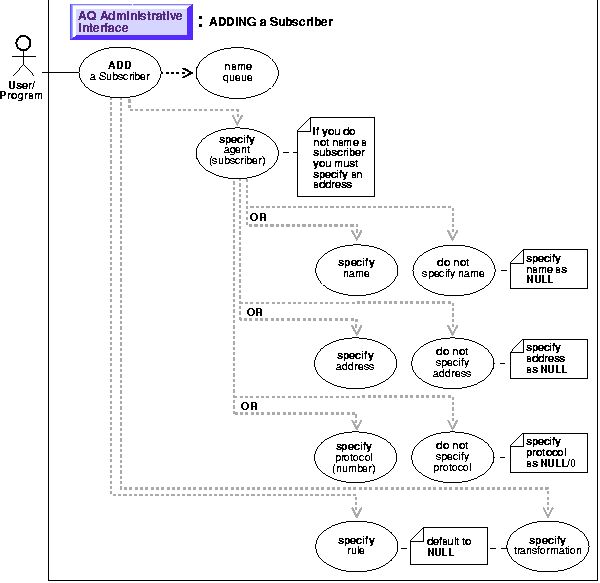Release 1 (9.0.1)
Part Number A88890-02
Home |
Book List |
Contents |
Index | Master Index | Feedback |
| Oracle9i Application Developer's Guide - Advanced Queuing Release 1 (9.0.1) Part Number A88890-02 |
|
Administrative Interface, 21 of 36

Adds a default subscriber to a queue.
rule => 'PRIORITY <= 3 AND CORRID = ''FROM JAPAN'''
Note that these are all single quotation marks.
DBMS_TRANSFORM package. (See theOracle9i Supplied PL/SQL Packages and Types Reference for more information.)
XMLType.existsNode() and XMLType.extract().
See Chapter 3, "AQ Programmatic Environments" for a list of available functions in each programmatic environment. Use the following syntax references for each programmatic environment:
See Chapter 3, "AQ Programmatic Environments" for a list of available functions in each programmatic environment. Examples are provided in the following programmatic environments:
/* Anonymous PL/SQL block for adding a subscriber at a designated queue in a designated schema at a database link: */ DECLARE subscriber sys.aq$_agent; BEGIN subscriber := sys.aq$_agent ('subscriber1', 'aq2.msg_queue2@london', null); DBMS_AQADM.ADD_SUBSCRIBER( queue_name => 'aq.multi_queue', subscriber => subscriber); END; /* Add a subscriber with a rule: */ DECLARE subscriber sys.aq$_agent; BEGIN subscriber := sys.aq$_agent('subscriber2', 'aq2.msg_queue2@london', null); DBMS_AQADM.ADD_SUBSCRIBER( queue_name => 'aq.multi_queue', subscriber => subscriber, rule => 'priority < 2'); END;
/* Add a subscriber with a rule and specify a transformation */ DECLARE subscriber sys.aq$_agent; BEGIN subscriber := sys.aq$_agent('subscriber2', 'aq2.msg_queue2@london', null); DBMS_AQADM.ADD_SUBSCRIBER( queue_name => 'aq.multi_queue', subscriber => subscriber, transformation => 'AQ.msg_map'); /* Where the transformation was created as */ EXECUTE DBMS_TRANSFORM.CREATE_TRANSFORMATION ( schema => 'AQ', name => 'msg_map', from_schema => 'AQ', from_type => 'purchase_order1', to_schema => 'AQ', to_type => 'purchase_order2', transformation => 'AQ.transform_PO(source.user_data)'); END;
DECLARE subscriber sys.aq$_agent; BEGIN subscriber := sys.aq$_agent('East_Shipping','ES.ES_bookedorders_que',null); DBMS_AQADM.ADD_SUBSCRIBER( queue_name => 'OE.OE_bookedorders_que', subscriber => subscriber, rule => 'tab.user_data.orderregion = ''EASTERN'' OR (tab.user_data.ordertype = ''RUSH'' AND tab.user_data.customer.country = ''USA'') '); END; /* Add a rule-based subscriber for Overseas Shipping */ DECLARE subscriber aq$_agent; BEGIN subscriber := aq$_agent('Overseas_DHL', null, null); dbms_aqadm.add_subscriber( queue_name => 'OS.OS_bookedorders_que', subscriber => subscriber, rule => 'tab.user_data.xdata.extract(''/ORDER_ TYP/ORDERTYPE/text()'').getStringVal()=''RUSH'''); END;
/* Setup */ public static void setup(AQSession aq_sess) throws AQException { AQQueueTableProperty qtable_prop; AQQueueProperty queue_prop; AQQueueTable q_table; AQQueue queue; /* Create a AQQueueTable property object */ qtable_prop = new AQQueueTableProperty("AQ.MESSAGE_TYP"); qtable_prop.setMultiConsumer(true); q_table = aq_sess.createQueueTable ("aq", "multi_qtab", qtable_prop); /* Create a new AQQueueProperty object: */ queue_prop = new AQQueueProperty(); queue = aq_sess.createQueue (q_table, "multi_queue", queue_prop); } /* Add subscribers to a queue */ public static void example(AQSession aq_sess) throws AQException { AQQueue queue; AQAgent agent1; AQAgent agent2; /* Get the queue object */ queue = aq_sess.getQueue("AQ", "multi_queue"); /* add a subscriber */ agent1 = new AQAgent("subscriber1", "aq2.msg_queue2@london"); queue.addSubscriber(agent1, null); /* add a subscriber with a rule */ agent2 = new AQAgent("subscriber2", "aq2.msg_queue2@london"); queue.addSubscriber(agent2, "priority < 2"); } /* Add a subscriber with a rule */ public static void example(AQSession aq_sess) throws AQException { AQQueue queue; AQAgent agent1; /* Get the queue object */ queue = aq_sess.getQueue("OE", "OE_bookedorders_que"); /* add a subscriber */ agent1 = new AQAgent("East_Shipping", "ES.ES_bookedorders_que"); queue.addSubscriber(agent1, "tab.user_data.orderregion='EASTERN' OR " + "(tab.user_data.ordertype='RUSH' AND " + "tab.user_data.customer.country='USA')"); }
|
|
 Copyright © 1996-2001, Oracle Corporation. All Rights Reserved. |
|